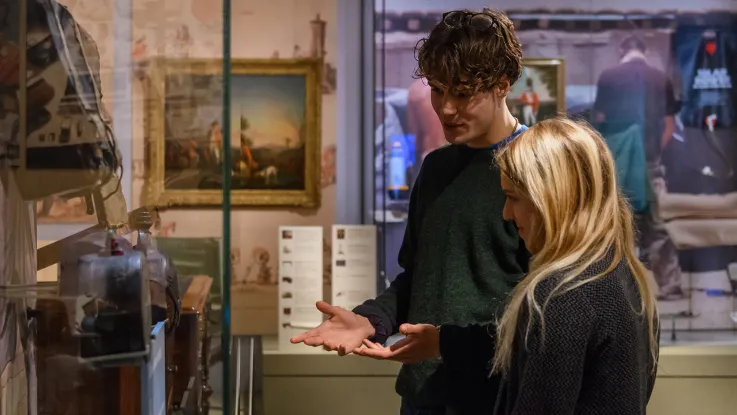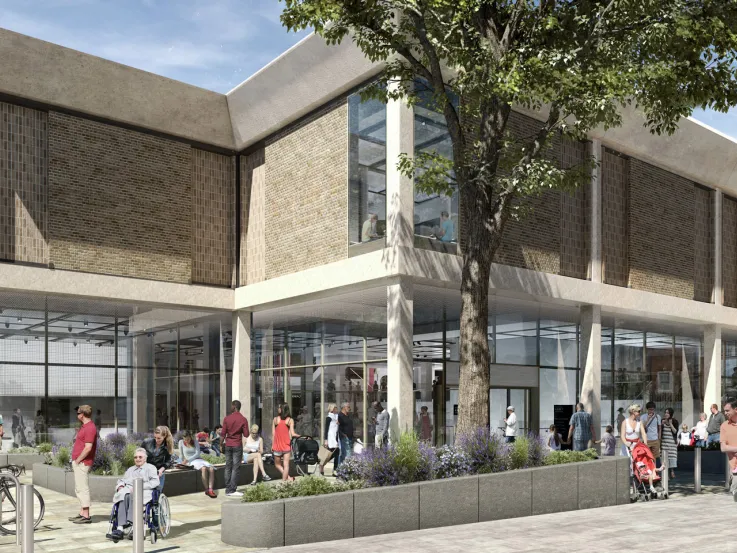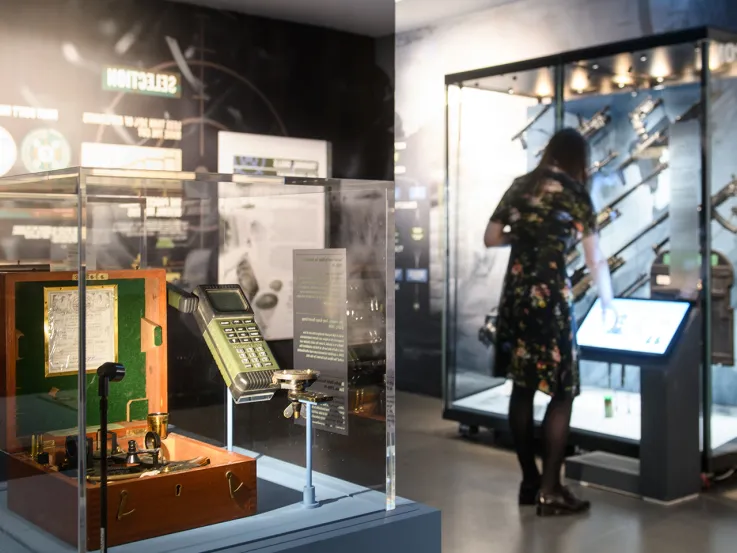Soldier gallery reopens to visitors at the National Army Museum

A child crawling under the Dingo scout car in Soldier gallery
Tuesday, 24 September 2024
The National Army Museum’s most popular permanent gallery – ‘Soldier’ – has reopened following a six-month refresh project.
The space has been refurbished to include new objects, drawing on visitor feedback to tell more personal stories about soldiers and their time in service. The reopening also sees the return of some of the Museum’s most loved displays and family interactives.
Soldier gallery charts the lives of soldiers fighting under the Crown across four centuries of service. From joining up to coming home, every aspect of Army life – from training and discipline, food, leisure and combat – is explored through the national collection of uniforms, equipment, art and archives cared for by the Museum.
The refreshed gallery tells five personal stories and follows these five soldiers throughout their time in service. Each is a remarkable record of action across the world. Over 60 new objects have been added to the displays, including poignant paintings, impressive uniforms, intimate personal possessions, and even a Victoria Cross dating from the Crimean War found by a ‘mudlarker’ on the banks of the Thames.
Belinda Day, Senior Curator at the National Army Museum, said:
'I love this gallery. It’s a real snapshot of army life across time, but what is most remarkable is the number of similarities between the experiences of soldiers in different eras – some things never change. One of my favourite new objects is a bullet removed from the lung of Gunner Alfred Lionel Smith. He was shot during the 1914 Battle of Le Cateau, at the start of the First World War, and captured. His family thought he had died, but he survived the war, and the bullet was only discovered when he collapsed twenty years later. Thirty-two surgeons from around the world watched the operation to remove the bullet, said to be the first surgery of its kind ever performed.'
Justin Maciejewski, Director of the National Army Museum, said:
'Our team has worked over several years to refresh and redisplay our permanent galleries. We’ve responded to feedback from our visitors who love seeing our authentic and historic collection, and want to know more about the soldiers behind the uniforms. I am particularly pleased that we’ve been able to include a little-known work by the famous Victorian artist Lady Butler, showing the Camel Corps in Eqypt, which is now part of our ‘Animals at War’ display. It’s an example of how many surprising and often poignant aspects of Army life are explored – there’s hardly an animal which hasn’t formed part of a soldier’s world over the years.'
Highlight objects
Study of a British Soldier with two camels, Camel Corps, Egypt, c1885
Lady Butler travelled to Wadi Halfa in 1886 and this is thought to be a study for the painting: ‘A Desert Grave: Nile Expedition 1885’ (since destroyed). On the reverse is an oil study of a Breton peasant boy c1887, a preliminary study for ‘To the Front’.
Bullet, news article and medal relating to Gunner Alfred Lionel Smith, Royal Field Artillery
Gunner Smith was shot twice at the Battle of Le Cateau (1914), before being captured as a prisoner of war. The bullet in his lung was not discovered for 21 years, until an x-ray at the Royal Brompton Hospital revealed it. Thirty-two surgeons from around the world watched the operation to remove it, said to be the first operation of its kind ever performed.
Thames Victoria Cross
This Victoria Cross (VC) was found by a ‘mudlarker’ on the banks of the Thames in 2015. It was dated 5 November 1854, indicating that it was awarded for the Battle of Inkerman, a crucial engagement in the Crimean War (1854-56). It was inspected by Hancocks (who manufacture VCs) as well as experts from various museums. They concluded that it was genuine, but that it had been damaged as a result of its immersion in the Thames.
How the VC ended up in the Thames remains a mystery, and it is still not possible to determine which soldier it belonged to. There are only two VCs for Inkerman that remain unaccounted for - those awarded to Privates John McDermond and John Byrne - so the likelihood is that this cross belonged to one of them. Both demonstrated incredible bravery at a young age and their actions deserve to be remembered. The full story is available here: https://www.nam.ac.uk/explore/thames-vc-mystery
Geary family medals
This collection of medals represents a century of service. The medals cover three generations of the Geary family who all served with the Army from about 1856 to 1952: Sergeant John Geary, Sergeant Thomas Geary and Sergeant Ray Geary. The Army that Sergeant John Geary joined in the 1850s would have been almost entirely different to the Army that Sergeant Ray Geary, his grandson, left in the 1950s. What was the same for all of them was the camaraderie and the sense of regimental identity.
Completion of refresh programme
This gallery is the last stage of a programme of refreshment of the National Army Museum’s permanent exhibition spaces. Drawing on five years of visitor feedback and new scholarship, these new galleries help visitors engage with the history and heritage of soldiers and understand their impact in Britain and abroad. The Museum now has more objects on display across all the galleries, with new display spaces in each to allow for new acquisitions and updates.
Special events
Guided Tour: Soldier with Soldiers
25, 26 and 29 September 2024
£10.00
A new tour has been launched to celebrate the reopening of Soldier gallery, as part of the annual Chelsea History Festival. Experience an exclusive guided tour of the newly refreshed Soldier, in the company of two serving officers. Captain AJ Scott and Second Lieutenant TJ Mcloughlin will bring their own perspective as serving soldiers to the history and personal stories behind the objects in the gallery.
For more information and to book tickets, please visit: https://chelseaheritagequarter.co.uk/events/?venues=national-army-museum&event_type=tour
Notes to editors
For more information, please contact the Communications Team at press@nam.ac.uk
Images and caption sheet available here: https://tinyurl.com/33jhfktm
Join the conversation:
- Twitter: @NAM_London
- Facebook: facebook.com/NationalArmyMuseum
- Instagram: @nam_london
National Army Museum
The National Army Museum shares the history and heritage of our soldiers and their service in the Army, across the globe and down the centuries. Through our collections we explore the history of the Army from its origins to the present day. We aim to engage and inspire everyone with the stories of our soldiers and how their service shapes our world; past, present and future.
Chelsea Heritage Quarter
The Chelsea Heritage Quarter is London’s new heritage destination and brings together four remarkable institutions to tell a unique story of London and Britain from 1660 to the present day. Including magnificent architecture, military history and London’s oldest botanic garden all situated in the heart of historic and picturesque Chelsea, the Quarter presents a fascinating and wide-ranging experience for those interested in exploring Britain’s history.
Chelsea History Festival
Founded in 2019, the Chelsea History Festival is a partnership between the National Army Museum, the Royal Hospital Chelsea and Chelsea Physic Garden. Its aim is to entertain, educate and inspire through local, national and global history. Every year, the Chelsea History Festival brings the past to life through a programme of events, featuring a brilliant blend of storytellers and performers from different walks of life. The Festival creates a stage in Chelsea, along the historic Royal Hospital Road, for world class speakers and authors to celebrate history.



